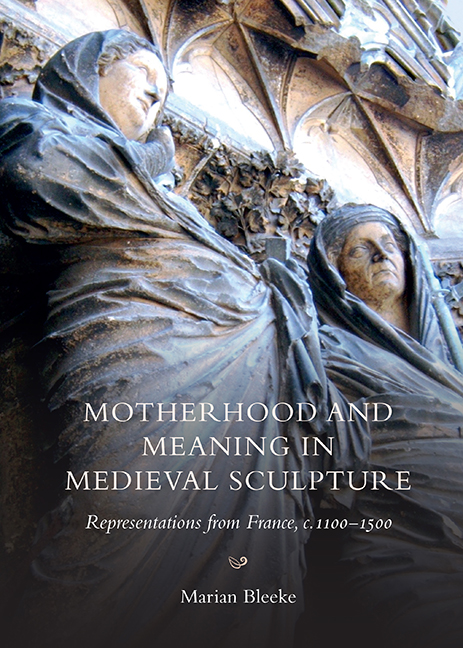Book contents
- Frontmatter
- Contents
- List of Illustrations
- Acknowledgments
- Introduction: Motherhood and Meaning in Medieval Sculpture
- 1 Motherhood as Transformation: From Annunciation to Visitation at Reims
- 2 Motherhood as Monstrosity: The Moissac Femme-aux-serpents and the Transi of Jeanne de Bourbon-Vendôme
- 3 Resurrecting Lazarus: The Eve from Saint-Lazare at Autun
- 4 Visualizing Parturition: Devotional Sculptures of the Virgin and Child
- Afterword: Motherhood and Meaning: Medieval Sculpture and Contemporary Art
- Bibliography
- Index
- Already Published
4 - Visualizing Parturition: Devotional Sculptures of the Virgin and Child
Published online by Cambridge University Press: 29 May 2021
- Frontmatter
- Contents
- List of Illustrations
- Acknowledgments
- Introduction: Motherhood and Meaning in Medieval Sculpture
- 1 Motherhood as Transformation: From Annunciation to Visitation at Reims
- 2 Motherhood as Monstrosity: The Moissac Femme-aux-serpents and the Transi of Jeanne de Bourbon-Vendôme
- 3 Resurrecting Lazarus: The Eve from Saint-Lazare at Autun
- 4 Visualizing Parturition: Devotional Sculptures of the Virgin and Child
- Afterword: Motherhood and Meaning: Medieval Sculpture and Contemporary Art
- Bibliography
- Index
- Already Published
Summary
Like the fourteenth-century sculpture featured in the Introduction (Fig. 1, Plate I), this fifteenth-century Virgin stands with her weight shifted to the left, to where she holds the child on her hip with her hand (Fig. 26). A comparison of the two sculptures, however, points to the latter's accentuation of the twists and sways in the mother's body. Here, the draperies on Mary's lower body form thick folds that move on curves and angles over to the child, and the top of her body repeats that action as her head bends over and down towards him. These curves extend this Virgin's body out sideways, creating a breadth to her form. That breadth is further extended as she holds her right hand out and away from her body and uses it to hold her draperies likewise out and away. These draperies fall from her hand to fill the space that would otherwise be emptied by her shift to the side and form broad folds that zig-zag from side to side, further emphasizing the horizontal expanse of her form.
As discussed in the Introduction, the fourteenth-century sculpture simultaneously presses the mother and child together within its narrow vertical format, links them through the child's reach for Mary's veil, and splits them apart by contrasting her looping drapery folds to his tight vertical pleats. The fifteenth-century sculpture introduced here uses some similar drapery forms, but to different ends. Here, too, curving folds cross over the Virgin's body; however, the folds on this sculpture become lines that lead into the child's body and so work to integrate him into her ample form. One particularly prominent line runs from her extended arm in a deep fold across her body, into the scroll he holds in his hand, and then into his legs and her supporting hand. Below this major line, two additional folds cross over her body and lead into his legs, and above it, a fold crosses her chest to run into his lower arm.
- Type
- Chapter
- Information
- Motherhood and Meaning in Medieval SculptureRepresentations from France, c.1100-1500, pp. 120 - 158Publisher: Boydell & BrewerPrint publication year: 2017



